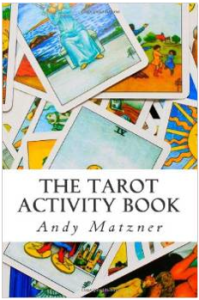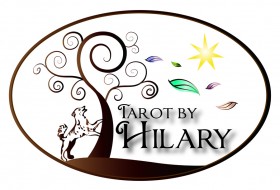
Book: The Tarot Activity Book
Author: Andy Matzner
Date of Publication: March 2013
Published by: CreateSpace Independent Publishing Platform
PLEASE NOTE: A review copy of this book was provided by the publisher.
“A book should serve as the axe for the frozen sea within us.”—Franz Kafka
“At the center of your being you have the answer; you know who you are and you know what you want.”—Lao Tzu
So starts Andy Matzner’s The Tarot Activity Book… a book that endeavors to crack open a person’s layers to get to the heart of themselves to the answers they seek… this book is the proverbial “axe” that Franz Kafka spoke of in the above quote.
I have found that many tarot readers shy away from the fortune-telling aspects of divination and tend toward a more counseling approach… already facilatating a reading in much the same way a psychotherapist would counsel using Rorshach tests or allowing a patient to journal or artistically express their emotions.
Sometimes I will approach a reading in much the same way, not only reading a card but prompting my client to do similarly: “What do you see in this card? How does this card make you feel? What do you think is happening in this card? Tell a story about this card. How does this card to relate to your situation?” This deepens the reading and strengthens the bonds of trust and safety between reader and those being read.
This book can only help tarot readers that read in this way in that regard!
Divided into 3 main sections:
- Conversation Starters
- Writing and Journaling
- Arts and Crafts
No background information on the tarot is necessary to work with the activities listed in this book, but the introduction DOES have a small summary of how the tarot deck is structured and recommended reading in case someone wants to do further research into the tarot. The introduction also gives a necessary list of materials needed in order to do most of the activities in the book, such as arts and crafts supplies and recommendations of tarot decks. It is suggested that the classic Rider-Waite-Smith deck would be the best one to work with, but that recommendation is not rigid. The biggest note in the introduction that I was glad of was the warning that, yes, you will be cutting up and gluing tarot cards for some of these activities. My suggestion: Don’t use your cherished deck for that! Purchase a deck you would like to use to read from, and a separate deck with which to craft from. Or, as Andy says, “get used to manipulating tarot cards artistically.”
This could have easily been “just another activity book”. With the addition of the tarot, it becomes unique, because it acknowledges that “[Tarot] can allow a person to share what is important, without having to depend on the limitations of words.” I like to call this “tarot shorthand”, but sometimes it is better to have tarot background knowledge in order to understand that particular language… when I describe something as “a very 10 of Wands kind of day”, if a person doesn’t know what the 10 of Wands means or its traditional interpretation, they’re not quite likely to know what I mean. However, if I held up a picture of the 10 of Wands, they may get my meaning right away simply from the visual! For other situations, where “heartbreak” perhaps isn’t conveying the appropriate level of suffering, the 3 of Swords could be held up and then expounded upon.
Pros:
- Deep DEEP introspection. Some of my personal mottos are “Know Thyself” and “The unexamined life is not worth living.”—Socrates
Do my personal mottos resonate for you, too? Then this will be a dream of a book to read and work through. - Side benefit of learning the tarot in a profoundly personal way: You may never want to become a professional reader, nor read the cards for anyone else but yourself. This book will help you establish an incredibly strong bond with the images and archetypes of the tarot.
- This book would be a fabulous companion to Jude Alexander’s The Tarot Game.
- The activity “Mood Card(s)” would be a wonderful added component to Danielle LaPorte’s The Desire Map [affiliate link], especially the Option section. How do I want to feel? Pick a tarot card that best encapsulates that fleeting feeling you’re going after!
- Already familiar with tarot and tarot spreads? A majority of these activities can potentially be translated into a customized tarot spread! You bet I’ll be transforming the activity “Legacy” (all about family legacies) into a tarot spread for those clients that don’t know the difference between a negative family legacy (and patterns) and a curse.
Cons:
- If you already are familiar with tarot, some of these activities may be difficult for you to get out of your “tarot brain” in order to do them. For example, the activity “Relationships” the very first out of the Conversation Starters section, may be incredibly difficult to do while you are still in “tarot mode”. Why? Because it asks you to choose cards that represent different aspects of your life, such as relationship to your mother and father. In that case, I would automatically choose the Empress and the Emperor, respectively, simply because I know the both of them as the mother and father of the tarot deck. For this reason, I would recommend for seasoned tarot readers that some of these exercises outright NOT include the Major Arcana cards in order to really get the most meatiness out of them. (The author DOES provide an “Options” section after many of the activities that is a modification or addition to the original activity… and does suggest including the Minor Arcana.)
Overall, this book is deceptively simple in nature, but incredibly complex when you work with the cards in this manner. Some of the activities I had a visceral reaction to even from reading them (please see IMPORTANT below). Yes, you definitely CAN do the activities in this book alone, or with your clients if you are a professional reader. But please note what the author says in the introduction: “… these exercises and activities are designed to serve as the foundation for more in-depth therapeutic work by a trained helping professional.” Remember that not everyone has the same background knowledge or experiences, and an activity that wouldn’t bother one person could potentially be a very difficult one for another. Keep in mind that a tarot reader (no matter how professional or accurate) is not a substitute for a licensed medical professional.
I thoroughly enjoyed exploring the tarot in a completely different way than what I am used to.
Blessings,
~*~Hilary~*~
www.tarotbyhilary.com
*** IMPORTANT *** This is a wonderful book for self-work and inner work, but please keep in mind that for some of these exercises, it is recommended you work through them with the guidance of a licensed mental health counselor, therapist, or psychiatrist.
If you found this article helpful, please share it with your friends using the handy-dandy buttons below.


Sorry, comments are closed for this post.